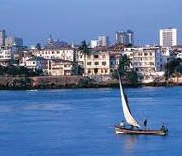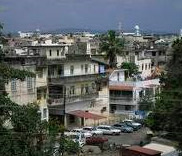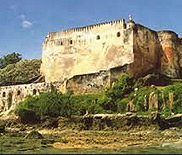Cultural and Anthropologist: Nairobi, Mombasa, Malindi, Lamu Kenya 574

Mombasa as seen from the habour

The Historical Mombasa town

Fort Jesus
Day spent at Leisure in Nairobi. Overnight at Hotel in Nairobi
Day 02: Nairobi - fly to Mombasa
Breakfast is served at the hotel then transferred to Wilson airport for your scheduled flight (9:30/11:00HRS). On arrival Mombasa airport met by our representative and transferred to your hotel.
Dinner and overnight Mombasa Serena Hotel.
Day 03: Nairobi - fly Mombasa
Breakfast is served at the hotel, then depart for a Mombasa city tour with picnic lunch for a visit to fort Jesus which was built by the Portuguese in 1593. The site chosen was a coral ridge at the entrance to the harbor. The Fort was designed by an Italian Architect and Engineer, Joao Batista Cairato. The earliest known plan of the Fort is in a manuscript Atlas by Manuel Godinho de Heredia - dated 1610, which shows the original layout of the buildings inside the Fort.
Fort Jesus was built to secure the safety of Portuguese living on the East Coast of Africa. It has had a long history of hostilities of the interested parties that used to live in Mombasa. Perhaps no fort in Africa has experienced such turbulence as Fort Jesus. Omani Arabs attacked the Fort from 1696 to 1698. The state of the Fort can be understood from the plan of Rezende of 1636 and other plans by Don Alvaro Marquis of Cienfuegas and Jose Lopes de Sa - made during the brief reoccupation by the Portuguese in 1728 - 1729. In the Cienfuegas plan, the names of the bastions are changed. Between 1837 and 1895, the Fort was used as barracks for the soldiers. When the British protectorate was proclaimed on the 1st of July 1895, the Fort was converted into a prison. The huts were removed and cells were built.
Evening Sight and sounds show at fort Jesus inclusive of Dinner.
Overnight Mombasa Serena Hotel.
Day 04: Mombasa
Breakfast is served at the hotel, then depart for a visit to Kisite Mpunguti Marine park, which is an ecosystem that covers a marine area with four small islands surrounded by coral-reef. Kisite Island is covered in low grass and herbs while Mpunguti Islands have dense coastal equatorial forest. Sea grasses Cymodocea serrulata and Syringodium isoetifolium cover a large area of the sub-littoral zone of the reef. Marine algae include Padina commersonii, Dictyota bartayresiana, Bostrychia binderi, Ulva lactuca, Dictyosphaora sp., Udotea indica, and Halimeda opuntia. Major attractions include the dolphins, coral gardens and it is an important site for snorkeling, diving and bird watching.
Dinner and overnight Mombasa Serena Hotel.
Day 05: Mombasa - Malindi
Breakfast is served at the hotel, then depart for Malindi with a visit to Gede ruins which are the remains of a Swahili town, typical of most towns along the East African Coast. It traces its origin in the twelfth century but was rebuilt with new town walls in the fifteenth and sixteenth centuries. This rebuilding is connected with the emigration of many citizens of Kilwa to Mombasa, Malindi and other places along the coast.
With its numerous inhabitants, the town became wealthy and it reached its peak in the fifteenth century. This enormous wealth is evidenced by the presence of numerous ruins, comprising of a conglomeration of mosques; a magnificent palace and houses all nestled in 45 acres of primeval forest. But in the first half of the seventeenth century the last families left the town.
Proceed on for Vasco da Gama pillar which is one of the oldest remaining monuments in Africa and was built in 1498 by the great Portuguese explorer, Vasco da Gama, as a sign of appreciation for the welcome he was given by the Sultan of Malindi.
Dinner and overnight Malindi Beach Hotel.
Day 06: Malindi
Breakfast and lunch is served at the hotel and day spent at leisure.
Dinner and overnight Malindi Beach Hotel.
Day 07: Malindi - fly Lamu
Breakfast is served at hotel, then transferred to the airport for your scheduled flight Malindi/Lamu. On arrival Lamu met and transferred to the hotel and you can have a walk in Lamu town with a visit to Lamu museum which commenced in 1813, shortly after Lamu?s victory over Pate and Mombasa in the battle of Shela. This major building task was reputedly undertaken with the cooperation of Seyyid Said, the Sultan of Oman who was then cultivating a promising new alliance with Lamu.
Upon its completion in about 1821 the fort marked the Southern corner of the traditional stone town and served as a garrison for Baluchi soldiers sent by the Sultan of Oman. Its protective presence encouraged new development around it. Thus confident Merchants erected the 19th century shopfront and buildings. By 1900 the Fort had become the image of the community, a role which it still plays to date.
Overnight at Lamu House.
Day 08: Lamu
Breakfast is served at the hotel then day spent at leisure.
Overnight at Lamu House.
Day 08: Lamu - fly Nairobi and depart
Breakfast is served at the hotel, then transferred to the airport for your scheduled flight (15:40/17:35HRS). On arrival Wilson airport met by our representative and transferred to Jomo Kenyatta International Airport for your scheduled international flight.

 German
German Spanish
Spanish





